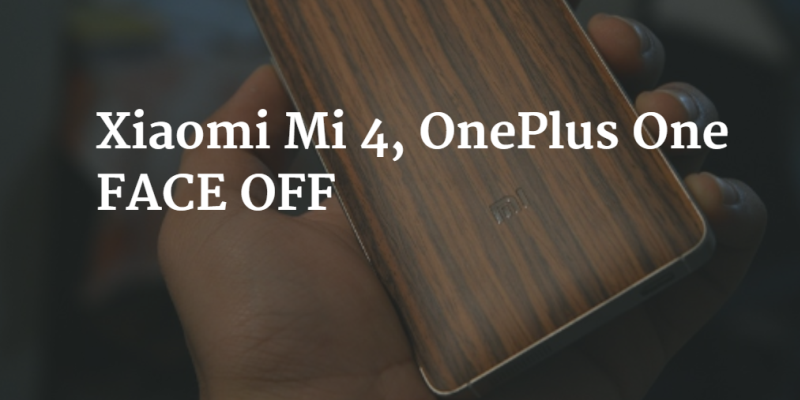Xiaomi Mi 4, OnePlus One battle it out on the ‘budget flagship’ war today
Xiaomi’s been quite a phenomenon for the Indian market. In less than a year, it has managed to change quite a few things as far as how the market operates; selling devices at near cost (some even suspect they sold the first few batches at a loss), online-only flash sales and then of course, forcing people to look beyond the Chinese maal stereotype. To be as successful as Xiaomi has been in its short stint on the market required a radical approach combined with a strong marketing plan, and thus far, one can safely say it has been successful at that.

OnePlus, on the other hand, is still on its way up. The company’s first phone -- OnePlus One -- was plagued with controversy both in the international and the Indian market. The ‘startup’ couldn’t manage to keep up with the demand in its initial months, which left a lot of its potential buyers furious. However, with time (and perhaps resources), OnePlus has managed to keep a steady flow of its Ones, and it is now easier to get one than ever before.
Later today, the 64GB version of Xiaomi’s erstwhile flagship -- the Mi 4, before the Mi Note took over -- will go on sale for the first time, through its usual channel, i.e., Flipkart. The phone is a masterpiece as per the makers, and fortunately for the company, a lot of its buyers concur. On the other hand, the OnePlus One’s (another device which has received rave reviews) base model with a 16GB capacity also goes on sale today, which is priced at 1,000 INR lesser than the Mi 4, at 18,999 INR (vs. the Mi 4’s 19,999 INR).
Both phones have pretty much the same set of internals powering them; the Xiaomi Mi 4 comes with a 2.5GHz quad-core Snapdragon 801 processor, 3GB RAM, 16GB/64GB on-board (non-expandable) storage, a 13 mega-pixel main camera and a 3080mAh battery. The OnePlus One features the same 2.5GHz Snapdragon 801 SoC, the same 3GB of RAM, offers 16GB/64GB storage variants, and a 3100mAh battery.
Differentiating factor
The only differentiating factor between the phones, hardware-wise, is the screen, which one the Mi 4 stands at 5-inch 1080p, while on the One, it’s a 5.5-inch 1080p panel (add to it, both screens are sourced from the same OEM - JDI). Once you look beyond that, there’s another massive difference (more so than the hardware, if you ask me) -- that of the OS the devices run on. Neither come with stock AOSP Android, but feature heavily modded versions. The OnePlus One comes with the Cyanogen OS (commercial flavour of the community CyanogenMod ROM), while the Mi 4 runs MIUI 6 (Xiaomi’s first product, which also happened to be their only product for their first year since foundation).
Xiaomi has managed to become more of what they call a ‘household name’ than OnePlus. While I can’t really fathom all of the contributing reasons, a major one certainly has to be the pricing of its first few phones -- the Mi 3, the Redmi 1S and the Redmi Note, more so than its most recent launch. The phones got the people talking, and the flash sales meant that supply was curated in a way that demand, at all times, remained higher than supply. Talk about capitalist marketing!
At four-and-a-half-years strong, Xiaomi also is more than twice as old as OnePlus. The company comes straight out of a thundering-successful stint in its home country of China. Their most high-profile recruit, and now their company’s global face -- Hugo Barra -- too has a major role to play in Xiaomi’s success as a truly international maker rather than just a Chinese company that ships its phones outside of China.
OnePlus has had more controversies going its way than comfort would allow, giving their disaster management team some crucial exercise. In the first few months of conception, OnePlus followed a rather unique marketing method that although gave the company a lot of media footage, also resulted in some negative publicity (something which the founders would’ve anticipated anyway). That’s a trade-off the company made, and it seems happy with it so far.
Sale war
To speak of today’s sale, the OnePlus One and the Mi 4 are two of the best phones in the market. But the so-called ‘war’ isn’t as fierce as it may sound; despite them having near identical specs, a huge difference still stays in the form of size. Old skool folk that swear by one-handed usage and mobility wouldn’t think twice before going for the Mi 4, while the more flexible section of the junta shouldn’t really be bothered by the Mi 4’s presence; the One with its ultra-light Cyanogen OS ROM is one of the fastest phones around. What you have to keep in mind though is the fact that you’ll have to have registered beforehand for the Mi 4 to be able to purchase the phone today, while for the OnePlus One, you’ll be required to be in possession of an ‘invite’.
About the author:
Yash is a lover of all things classic with a soft corner for the latest tech and trends. Road trips, 8-bit video-games and drones are what he lives for; well, at least at the time of writing this author bio. You can follow him on Facebook and Twitter, or say hi at [email protected].






